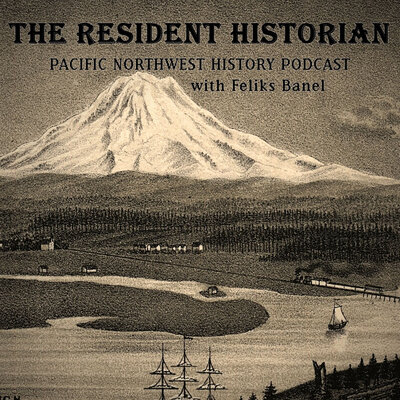
The Resident Historian Podcast
The Resident Historian is a twice-weekly podcast from KIRO Newsradio's Feliks Banel. Each episode includes either Feliks's Wednesday history feature from Seattle's Morning News, or the weekly Friday morning installment of the history and geography series All Over The Map.
Most Recent Episode
More Episodes

All Over The Map: Early 20th century artifact plucked from Lake Washington
On this week’s edition of All Over The Map for Seattle’s Morning News, we visited a pocket park on Mercer Island along the shores of Lake Washington. It was here where a "rich and creamy" reminder of the island’s history was recently discovered by a pair of divers.
Franklin Landing is a tiny street-end park on the west side of Mercer Island, essentially opposite Seward Park over on the Seattle side of Lake Washington. A dock at this location was a key piece of the "Mosquito Fleet" transportation infrastructure from the late 19th century to 1940, when the first Lake Washington Floating Bridge (which crossed Mercer Island) opened to vehicle traffic.
KIRO Newsradio was joined early Friday by Matt McCauley. He’s known to many as "Mr. Lake Washington History;" McCauley is an author, historian, underwater explorer and a good friend of Seattle’s Morning News.

Should we commemorate Seattle Founder’s Day?
The rain was falling and the wind was blowing on November 13, 2024, very much like it had done on this day 173 years ago. As many people learned as school children in Western Washington decades ago, it was way back on the morning of November 13, 1851, when the group considered to be the founders of Seattle landed at what’s now Alki Beach in West Seattle.
KIRO Newsradio interviewed Ken Workman early Wednesday beside the founder's monument at Alki. Workman's great-great-great-great grandfather is Chief Seattle, the city's namesake.

All Over The Map: Jackson Street Jazz Trail and sweet melodies among the sour notes
With the annual Earshot Jazz Festival now underway, the ribbon is about to be cut on a new path in downtown Seattle highlighting the history and culture of the golden age of jazz in Seattle along and near Jackson Street.
Paul de Barros is a longtime local journalist and author, and one of the founders of the Jackson Street Jazz Trail. De Barros, who wrote the seminal book about Seattle’s jazz history, the long out-of-print "Jackson Street After Hours," joined KIRO Newsradio live Friday morning from the "trailhead" at King Street Station.

All Over The Map: LiDAR tech reveals ghostly causeway, phantom lake on Eastside
The technology known as LiDAR – Light Detection and Ranging, a laser-driven means of making precise measurements over large areas – has been helping scientists understand geology and natural history for many years. It turns out that LiDAR is also pretty useful for plumbing the depths of recent human history too, including a phantom lake on the Eastside.

As Mount Adams quakes, a search for its heart and soul
As reported by KIRO Newsradio on last Friday’s edition of "All Over The Map," seismic activity at Mount Adams – known as Washington’s forgotten mountain for the way it’s tucked in behind Mount Saint Helens in a rural part of the state – picked up in September and got the attention of the United States Geological Survey (USGS).
It’s too early to tell what it all might mean, but KIRO Newsradio checked in with officials and business owners around the mountain to take the community’s pulse as the story, or non-story, slowly unfolds.